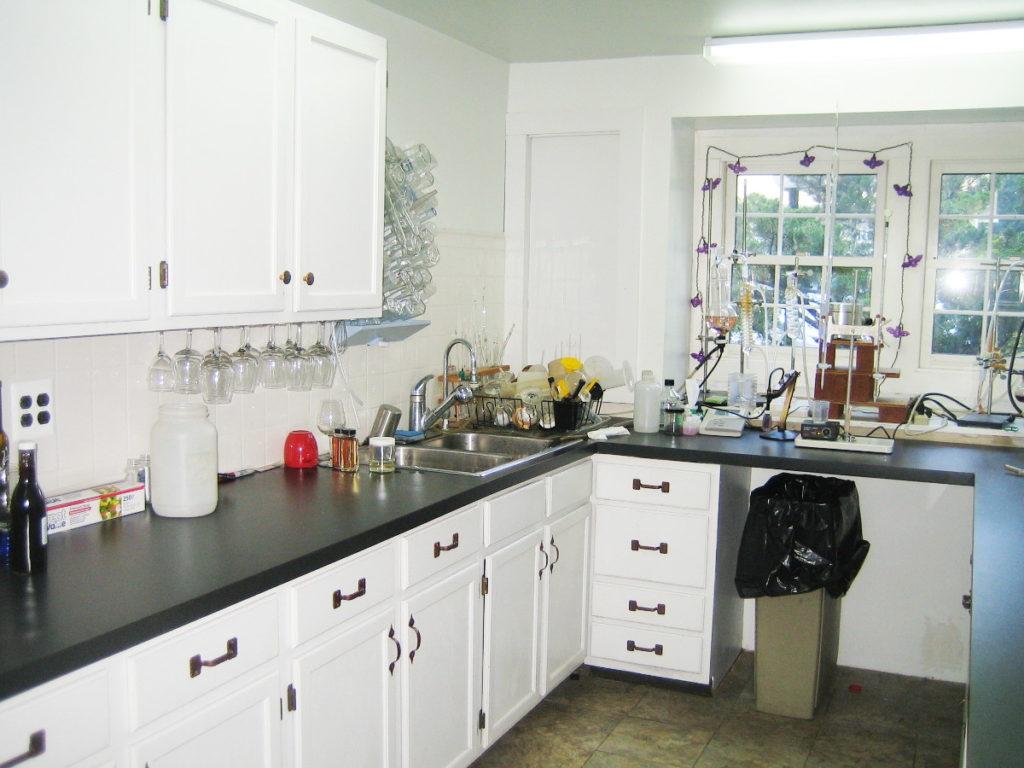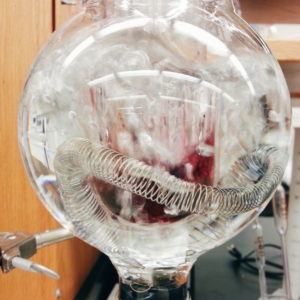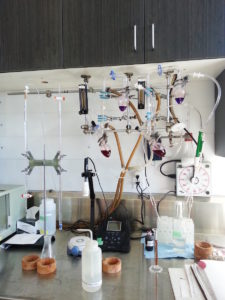
Photo by: Denise M. Gardner
Is wine analysis important?
If so, what should winemakers measure?
Today’s blog post hopes to answer both of these questions for winemakers. While the world of wine analysis is extensive and offers anything from measuring the pH of the wine to identifying potential wine microbes, testing the wine for quality assurance practices does not have to be extensive or overly expensive.
Why analyze wine post-primary?
If the wine is going onto malolactic fermentation
Post-primary analysis acts as another natural “baseline” in the wine’s production schedule. The other natural baseline is incoming raw material testing (i.e., fruit, juice, or concentrates). These baseline measurements are important to deduce a potential cause of a problem if a problem should arise later during production. For example, while many winemakers may choose to avoid volatile acidity (VA) measurements immediately post-primary, measuring the VA can provide valuable insight.
A high, or higher, VA post-primary indicates some sort of spoilage from the vineyard or issues during the fermentation. If spoilage during fermentation may have been a possibility, the winemaker can opt to investigate acetic acid bacteria levels in the wine. Should those levels be high, production steps such as increasing sulfur dioxide concentrations, treating the wine with an anti-microbial fining agent, or improving the monitoring practices for the wine may take place to avoid further degradation of the wine.

Photo by: Denise M. Gardner
Another benefit of taking the VA post-primary is having a reference for VA measurements that may get taken later in production. For example, if the VA is again measured post-malolactic fermentation or while the wine is in storage, the winemaker can compare the starting VA post-primary to the current VA. Large increases in the VA indicate acetic acid bacteria spoilage.
The failure to have baseline measurements results in a lot of guess work, which costs the winery time and resources. Ever treat a problem in a wine and later realize that wasn’t really the problem? It’s a good idea to put costs associated with the labor and products associated with such guess work to validate the cost of wine analysis.
One example surrounding guesswork also includes volatile acidity. Many winemakers approach me when they receive a VA measurement that is already at or above legal limits. At this point, while a problem is recognized, it is impossible to tell where the problem occurred in production. Furthermore, the problem could have been avoided with better monitoring like taking the time to get post-primary analysis completed.
If the wine is finished
Again, post-primary analysis acts as a baseline as the wine makes its way through stabilization, storage, and bottling operations.
There is always the potential for things to change, especially as the wine is treated with fining agents or enological product additions. Operations like blending can also alter the wine chemistry and behavior.
One example of post-primary baselines that could be important for wines not destined for MLF is measuring titratable acidity (TA). TA may not be desired immediately post-primary. However, for blending operations, it’s important to consider the TA in addition to pH, flavor, and alcohol percentages. TA provides the first indication for how sour a wine may taste. If a blending objective is to lower that perception, but manipulating with de-acidification agents may not be an option, then the winemaker can review the TAs of the various wines in inventory and identify a low TA wine to blend with the high TA wine, hence decreasing the acidity.
Minimum Post-primary Analyses to Complete
Post-primary analysis does not have to be extensive, but it should be thorough. Winemakers should create a standard operating procedure (SOP) on sampling newly completed wines and which analyses should get completed. Additionally, writing out protocols for each analysis is essential to ensure each employee is A) properly trained in conducting the analysis and B) that the analysis is completed consistency from employee-to-employee or year-to-year. The harvest period may not be the ideal moment to write protocols. However, this activity is always listed in the Post-Harvest Checklist Timeline, available exclusively to DGW Clients.
Focusing on the basic wine chemistry analyses can go a long way:
- pH: This measurement of acidity is a given as it determines the stability and activity of many wine components (e.g., free sulfur dioxide concentration, cold stability, protein stability, etc.). Keep in mind that the pH changes throughout wines’ production. Having the pH is an essential component of making free sulfur dioxide additions. For a review on pH, the webinar “pH Explained” is available for DGW Clients and Darn Good Winemakers members.
- Alcohol: Not only is measuring an alcohol a requirement by the Alcohol and Tobacco Tax and Trade Bureau (TTB), but this can again act as a baseline if the wine is destined for aging in tank or barrel. Note that alcohol percentages can change through aging.
- Residual Sugar: Don’t make the mistake of assuming that 0°Brix on the hydrometer equals no residual sugar (RS) left in the wine! Winemakers should always get the residual sugar checked enzymatically to ensure the wine is dry (<1 g/L of residual sugar) if the intent is to make a dry wine. Many are surprised that even when the hydrometer falls into negative ranges, there could be a decent amount of residual sugar left in the wine.
- Total Sulfur Dioxide: Taking the total sulfur dioxide concentration post-primary acts as a good reference point. This is especially important if the grapes or juice were treated with sulfur dioxide pre-fermentation or if the winery received sulfur dioxide treated concentrates meant for fermentation. Remember that the total sulfur dioxide concentration is cumulative and is also the sulfur dioxide component regulated by the TTB. Free sulfur dioxide additions should not be made without knowing the current total sulfur dioxide.
- Volatile Acidity: Volatile acidity (VA) is also regulated by the TTB. Wine is an intermediate product between juice and vinegar. Monitoring the VA is a way to ensure the wine is not fully souring, while also managing potential spoilage of the wine.
Some texts or individuals may recommend measuring malic acid concentration and free sulfur dioxide content. These are potential options for a winemaker post-primary fermentation.

Photo by: Denise M. Gardner
In the essence of cost, I do not usually recommend malic acid concentrations unless there is a unique case with the wine or I know the wine is going to through malolactic fermentation (MLF). In this case, the malic acid concentration acts as a baseline that can be monitored through the progression of MLF. Otherwise, I make an assumption the malic acid is in the wine. This helps me remain conscientious of free sulfur dioxide concentrations to inhibit native MLF.
Free sulfur dioxide concentration is important, but I do not usually recommend measuring free sulfur dioxide until after sulfur dioxide additions are being made. This allows the winemaker to evaluate how efficient additions are and keep an eye on required levels to inhibit spoilage.
Want to know more about wine analysis?
If you are looking to upgrade your wine analytical skills, Denise Gardner Winemaking addresses this topic in a number of ways. I work with all of my clients in a consulting package to better incorporate wine analysis and use the numbers to guide their winemaking decisions with ease and consistency. Clients receive reminders for when the optimum time is to take certain measurements and receive as-needed guidance for troubleshooting wines. New consulting agreements will be open in January 2020. Think you may be interested? Schedule an introductory call with Denise before the New Year by emailing info@dgwinemaking.com.
Or, if you’re not in the market for a consultant, but need a resource now-and-again, consider joining our Darn Good Winemakers membership. Each annual membership is $400, and you’ll receive:
- Monthly live webinars
- Monthly “Winemaking Advice Hours” with Denise and other Darn Good Winemakers members where you can ask your winemaking questions
- Access to past Darn Good Winemakers webinars within a calendar year Exclusive email content and reminders
One of our past webinars focused on designing or upgrading the winery’s lab. However, all webinars are designed based on the time of year and members’ needs. Have questions on becoming a part of the Darn Good Winemakers? Check out this page’s summary on membership benefits!
